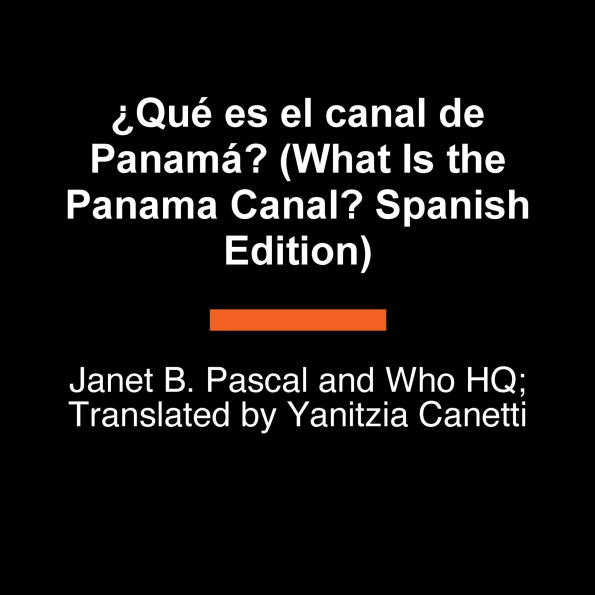What Is the Panama Canal?
Un hombre, un plan, un canal, ¡Panamá!
Antes de 1914, viajar desde la costa este hasta la costa oeste significaba cruzar por tierra todo Estados Unidos. Hacerlo por mar implicaba un largo viaje hacia el sur, rodeando Sudamérica y luego subiendo por la costa del Pacífico. Pero entonces, en una hazaña de ingeniería peligrosa y asombrosa, se excavó un canal de 48 millas de largo a través de Panamá, creando el atajo más famoso del mundo: ¡el canal de Panamá!
ENGLISH DESCRIPTION
A man, a plan, a canal, Panama. Not only is this palindrome clever, it also gives a brief description of the Panama Canal.
Before 1914, traveling from the East Coast to the West Coast meant going by land across the entire United States. To go by sea involved a long journey down and around South America and back north along the Pacific Coast. But then, in a dangerous and amazing feat of engineering, a forty-eight-mile-long channel was dug through Panama, creating the world's most famous shortcut: the Panama Canal!
1147152807
Antes de 1914, viajar desde la costa este hasta la costa oeste significaba cruzar por tierra todo Estados Unidos. Hacerlo por mar implicaba un largo viaje hacia el sur, rodeando Sudamérica y luego subiendo por la costa del Pacífico. Pero entonces, en una hazaña de ingeniería peligrosa y asombrosa, se excavó un canal de 48 millas de largo a través de Panamá, creando el atajo más famoso del mundo: ¡el canal de Panamá!
ENGLISH DESCRIPTION
A man, a plan, a canal, Panama. Not only is this palindrome clever, it also gives a brief description of the Panama Canal.
Before 1914, traveling from the East Coast to the West Coast meant going by land across the entire United States. To go by sea involved a long journey down and around South America and back north along the Pacific Coast. But then, in a dangerous and amazing feat of engineering, a forty-eight-mile-long channel was dug through Panama, creating the world's most famous shortcut: the Panama Canal!
What Is the Panama Canal?
Un hombre, un plan, un canal, ¡Panamá!
Antes de 1914, viajar desde la costa este hasta la costa oeste significaba cruzar por tierra todo Estados Unidos. Hacerlo por mar implicaba un largo viaje hacia el sur, rodeando Sudamérica y luego subiendo por la costa del Pacífico. Pero entonces, en una hazaña de ingeniería peligrosa y asombrosa, se excavó un canal de 48 millas de largo a través de Panamá, creando el atajo más famoso del mundo: ¡el canal de Panamá!
ENGLISH DESCRIPTION
A man, a plan, a canal, Panama. Not only is this palindrome clever, it also gives a brief description of the Panama Canal.
Before 1914, traveling from the East Coast to the West Coast meant going by land across the entire United States. To go by sea involved a long journey down and around South America and back north along the Pacific Coast. But then, in a dangerous and amazing feat of engineering, a forty-eight-mile-long channel was dug through Panama, creating the world's most famous shortcut: the Panama Canal!
Antes de 1914, viajar desde la costa este hasta la costa oeste significaba cruzar por tierra todo Estados Unidos. Hacerlo por mar implicaba un largo viaje hacia el sur, rodeando Sudamérica y luego subiendo por la costa del Pacífico. Pero entonces, en una hazaña de ingeniería peligrosa y asombrosa, se excavó un canal de 48 millas de largo a través de Panamá, creando el atajo más famoso del mundo: ¡el canal de Panamá!
ENGLISH DESCRIPTION
A man, a plan, a canal, Panama. Not only is this palindrome clever, it also gives a brief description of the Panama Canal.
Before 1914, traveling from the East Coast to the West Coast meant going by land across the entire United States. To go by sea involved a long journey down and around South America and back north along the Pacific Coast. But then, in a dangerous and amazing feat of engineering, a forty-eight-mile-long channel was dug through Panama, creating the world's most famous shortcut: the Panama Canal!
8.0
Pre Order
5
1
8.0
Pre Order

Product Details
| BN ID: | 2940193873280 |
|---|---|
| Publisher: | Penguin Random House |
| Publication date: | 12/16/2025 |
| Series: | ¿Qué fue? |
| Edition description: | Unabridged |
| Language: | Spanish |
| Age Range: | 8 - 11 Years |
From the B&N Reads Blog

